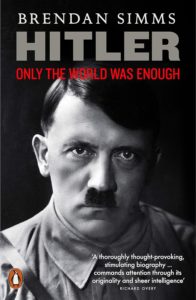 Hitler was also increasingly interested in the United States, which he came to regard as the repository of (in his view) all the best European racial elements, including the supposedly better sort of Germans. He remarked that, unlike Germany, which admitted swarms of eastern Jews, ‘yellow people are not allowed to settle in America’. In August 1922 he was introduced to Kurt Lüdecke, who had spent some time on business in the United States and whom Hitler would later send as an emissary across the Atlantic. In the middle of that month, Rudolf Hess wrote on Hitler’s behalf to the legendary automobile manufacturer, and fervent anti-Semite, Henry Ford for support. Moreover, Anglo-America was also becoming interested in Hitler. He had appeared on the radar of the British Foreign Office as early as 1920, and by later 1922 he was firmly established in their minds as a figure to be reckoned with, but there was no attempt to make contact with him.
Hitler was also increasingly interested in the United States, which he came to regard as the repository of (in his view) all the best European racial elements, including the supposedly better sort of Germans. He remarked that, unlike Germany, which admitted swarms of eastern Jews, ‘yellow people are not allowed to settle in America’. In August 1922 he was introduced to Kurt Lüdecke, who had spent some time on business in the United States and whom Hitler would later send as an emissary across the Atlantic. In the middle of that month, Rudolf Hess wrote on Hitler’s behalf to the legendary automobile manufacturer, and fervent anti-Semite, Henry Ford for support. Moreover, Anglo-America was also becoming interested in Hitler. He had appeared on the radar of the British Foreign Office as early as 1920, and by later 1922 he was firmly established in their minds as a figure to be reckoned with, but there was no attempt to make contact with him.
By contrast, the United States embassy, probably influenced by Mussolini’s coup in Italy, decided to take a closer look at this rising politician. In November 1922, the US assistant military attaché to Germany, Captain Truman Smith, came down from Berlin and met with Hitler on 20 November. Hitler argued that he was America’s best chance of keeping the Bolsheviks out of Germany, condemned monarchy as ‘an absurdity’, claimed that ‘dictatorship’ was the only answer, denied any plans for a war against France and railed against ‘the present abuse of capital’. To be sure, these were all things that the American wanted to hear—apart from the remarks on capitalism—but they also represented Hitler’s genuine views. One way or the other, the two men—both Wagnerians—seem to have hit it off. A ‘marvelous demagogue’, Smith wrote a few days later. ‘I have rarely listened to such a logical and fanatical man. His powers over the mob must be immense.’
It was Smith who put Hitler in touch with Ernst ‘Putzi’ Hanfstaengl immediately after their meeting. Hanfstaengl epitomized the relationship between Germany and the United States, which was to play such a central role in Hitler’s thinking and policy over the next twenty years or so. Hanfstaengl’s maternal grandfather, Wilhelm Heine, had emigrated to America as a liberal refugee from the failed 1848 revolution. He reached the rank of brigadier-general in the Union Army and served as a pallbearer at Lincoln’s funeral. Hanfstaengl’s father owned a large art business in Munich. Hanfstaengl himself was partly brought up in the United States, where he attended Harvard University and was personally acquainted with the young Franklin Delano Roosevelt. From 1912, he had run the New York branch of his father’s business. Hanfstaengl spent the war—which killed a brother fighting on the German side—in America. The business was ruined by the American entry into the conflict and the associated ‘Trading with the Enemy Act’. Hanfstaengl became an enemy alien: the insider had become an outsider.
Over the next year, Hanfstaengl and Hitler were in almost daily contact. Hanfstaengl impressed upon Hitler not only the immense industrial and demographic power of the United States, but the fact that every German had a close relative there or in some other part of the world, something of which Hitler was already well aware. He argued that the party needed to reach out to the world through a coordinated foreign press policy. Hanfstaengl now became effectively the NSDAP’s external media liaison officer. He also entertained Hitler with his piano, playing from a repertoire which included not only Wagner but Harvard football marches. Captain Mayr later recalled the ‘American methods of salesmanship’ used to push out the Nazi message. The United States thus increasingly became a model as well as a rival.
One reply on “Hitler, 32”
I had not seen the data until recently but there was huge immigration of Germans to USA from 1840-1914. They were the 2nd largest group immigrating to USA, with British isles people been first. The fact that they were so easily convinced to fight their German brothers in WW1 and WW2 is disturbing.
But note, the vast majority of USA armed forces in WW2 were conscripts, so its a propaganda lie oft repeated that there was some noble enlistment by Americans to fight Nazism in WW2.